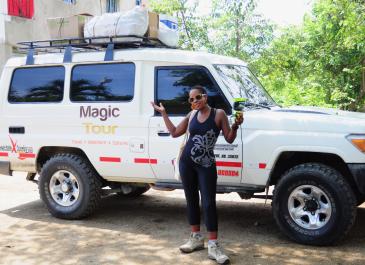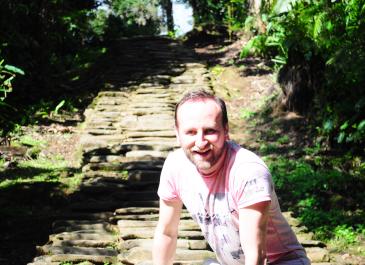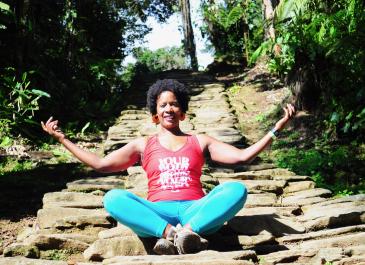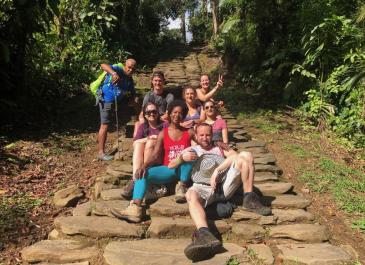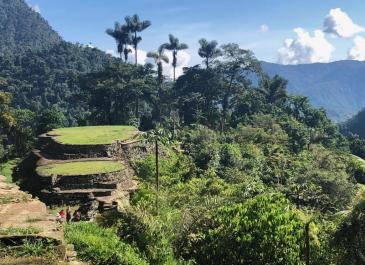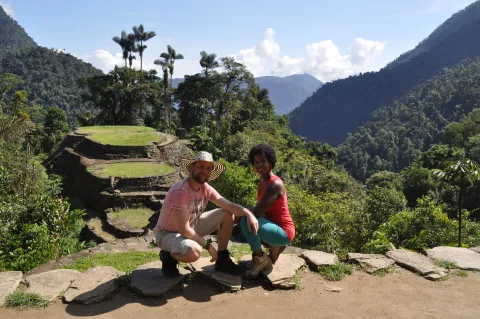This is a hike I'd been wanting to do for some time. Deep in the middle of La Sierra Nevada of Colombia a lost city was discovered in 1972 which is a very modern discovery in contrast to Machu Picchu. It even predates the latter by about 650 years!
To give you an idea of the geology, la Sierra Nevada de Santa Marta is a mountain range in the north of Colombia and it's peak Pico Simón Bolivar which stands at 5,710masl is the highest peak in the world which is near the sea only 42kms away.
This was a 4 day / 3 night trek and we booked it with magictourcolombia.com. We were thoroughly impressed with our guide Walter who at aged 64 had treked to "Teyuna" -actual name - 567 times including the 1,200 steep steps starting from the Buritaca river to the 1st terrace (500 more all the way to the top!).
We arrived at the entrance of Teyuna park around midday. The first trek was easy and if anything a little boring. Top tip: You can do this in 3 days by doing most of day 1 in a mototaxi. The end of Day 1 and beginning of day 2 are quite hard in particular if it's rained and sadly one of those in our group had to stay behind due to her knee early on day 2.
Another top tip: I'd hate to go in high or busy season. The accommodation facilities for night one are basic and I can imagine it getting cramped. Fortunately for us it only had a 20-30% occupation at the end of May.
The camp at the end of day 2 is much larger and next to the Buritaca river where your final ascent to the ancient terraces begin on day 3. All along the trek I tried to carry our backpack but towards the end I ate humble pie and asked for help from our guides.
Meeting a local Mamo
Thanks to our guide we also managed to meet a local Mamo - their englightened spiritual leader or chieftain. But what really stood out from this trip has marked me. We heard many stories from our guide about the local tribes, the Kogi, Wiwa & Arhuacos. Their culture had a strong focus on being productive members within their communities through working on their crops and land. So much so that recently born babies are wrapped in cloth and hung on trees while the mother worked the land regardless of the crying or even being stung by bees. Walter described how a a blind boy eventually went missing and the intimation was that he was a deadweight which needed too much attention and care.
A lesson that marked me
But was most struck me in this trip was that their native culture were dying. Their language, their traditions and their heritage. And as a tourist I was and active participant in this decline. They fought for their land and some are relatively rich landowners who are receiving income from out tourism. The last camp was very modern and built by the locals. They no longer bother growing crops as they eat our leftovers. They no longer make their traditional attire by hand as it's cheaper to head to the city of Santa Marta and buy it.
And I'm ok with this all. Why? Because sadly and in my opinion their culture and traditions are weak because do not have a written tradition. From at early age the young men are taught to stick on a Poporo some crushed sea shells mixed with the cocoa they chew forming layers on the poporo as a daily diary. And this diary is interpreted by the Moma as spiritual guidance. It's difficult to describe in words so I recommend watching it.
I wrestled in my mind for a while with my active participation in this active extinction. The reality is that I don't see their traditions lasting long in particular given how tourism is already having a large effect. It's sad but it's life. It's a cycle which will meet it's end.
Strava Relive
We had issues with our first day of Strava but here are the last 3 days:
